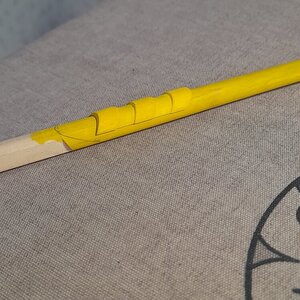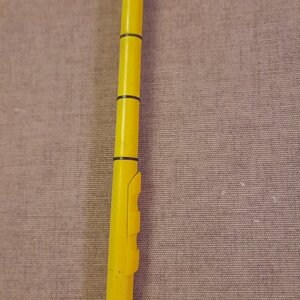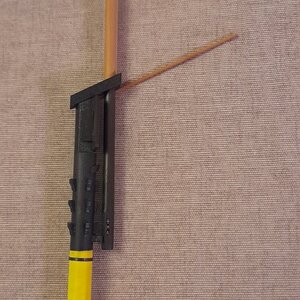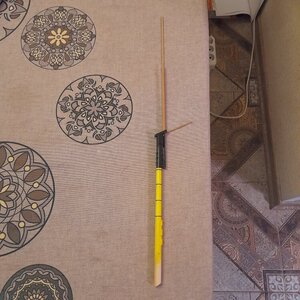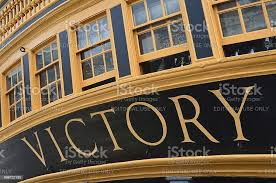Good morning Alexander. You are building a proper Victory here. Brilliant. Cheers Grantbowsprit with a jib so far looks like this.
You also need to make a pillow for the water voulings. Like in anatomy.
View attachment 304048View attachment 304049View attachment 304050
-

Win a Free Custom Engraved Brass Coin!!!
As a way to introduce our brass coins to the community, we will raffle off a free coin during the month of August. Follow link ABOVE for instructions for entering.
You are using an out of date browser. It may not display this or other websites correctly.
You should upgrade or use an alternative browser.
You should upgrade or use an alternative browser.
Model VICTORY by Deagostini, scale 1/84 [COMPLETED BUILD]
- Thread starter Alexander74
- Start date
- Watchers 84
-
- Tags
- deagostini victory
- Joined
- Sep 3, 2021
- Messages
- 5,115
- Points
- 738

Exquisite modeling!bowsprit with a jib so far looks like this.
You also need to make a pillow for the water voulings. Like in anatomy.
View attachment 304048View attachment 304049View attachment 304050
It looks like I missed one point and did not show it to you, dear colleagues. When I was making the tops, the masts were made at the same time. Now I am installing the yokes and on top of them the front fish. The front fish was installed on the fore and main masts, there was no front fish on the mizzen mast. I read back in Nelson's Anatomy of Ships that during the construction of the ship there were woolings on the masts, but by the time of the Battle of Trafalgar they had been replaced with iron yokes. The yokes are made of brass strips 0.2 mm thick, 0.8 mm wide and blackened. The result of the work on the photo. If you have any questions, I'll be happy to answer.
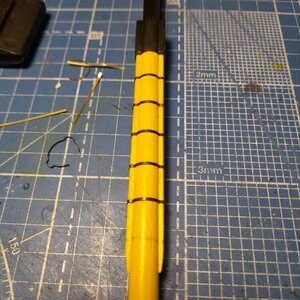
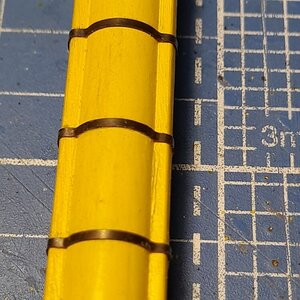
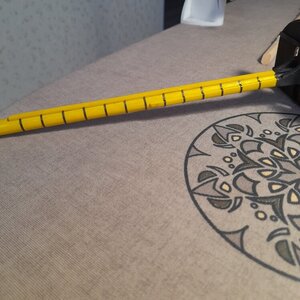
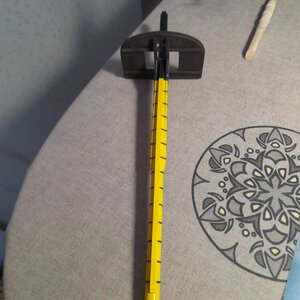
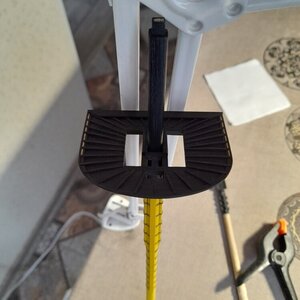





Kurt, hello. Over time, it will rub off and be dirty yellow. And about the colors on the ship museum in Portsmund, I talked with one of the people who worked in this museum. He says that the current color on Victory has nothing to do with the present. In addition, my masts fit into the general background of the ship with its yellow sides.The yellow color appears too bright. I think the HMS victory color is more tan and should be as below:
View attachment 304975
View attachment 304976
- Joined
- Sep 3, 2021
- Messages
- 5,115
- Points
- 738

Immaculate modeling, kudos!It looks like I missed one point and did not show it to you, dear colleagues. When I was making the tops, the masts were made at the same time. Now I am installing the yokes and on top of them the front fish. The front fish was installed on the fore and main masts, there was no front fish on the mizzen mast. I read back in Nelson's Anatomy of Ships that during the construction of the ship there were woolings on the masts, but by the time of the Battle of Trafalgar they had been replaced with iron yokes. The yokes are made of brass strips 0.2 mm thick, 0.8 mm wide and blackened. The result of the work on the photo. If you have any questions, I'll be happy to answer.
View attachment 304965View attachment 304966View attachment 304967View attachment 304968View attachment 304969
Hi Sasha!
Very clean work on the Victory. I am always interested in the how the materials are processed. What kind of glue did you use to glue the tapes to the mast, how did you prevent the glue from oozing out and smearing?
Best regards
Thomas
Very clean work on the Victory. I am always interested in the how the materials are processed. What kind of glue did you use to glue the tapes to the mast, how did you prevent the glue from oozing out and smearing?
Best regards
Thomas
Hello Thomas.Hi Sasha!
Very clean work on the Victory. I am always interested in the how the materials are processed. What kind of glue did you use to glue the tapes to the mast, how did you prevent the glue from oozing out and smearing?
Best regards
Thomas
Glue for yokes used like this. This is cyanoacrylate glue, but in the form of a gel. I applied it with a needle, in a very thin layer.
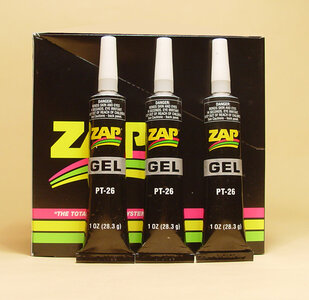
Ahh Kurt the Victory color debate....hours of articles here and still continued dispute... I went for pinky color ( as in photo above ) but is fading into a fleshy color. Eish. Even the academics can’t decide on which color reflects the Victory at which time. I guess that gives us freedom to choose which everThe yellow color appears too bright. I think the HMS victory color is more tan and should be as below:
View attachment 304975
View attachment 304976
 .
.BTW Sasha brilliant detail on the bowsprit and masts. Cheers Grant
Thanks GrantAhh Kurt the Victory color debate....hours of articles here and still continued dispute... I went for pinky color ( as in photo above ) but is fading into a fleshy color. Eish. Even the academics can’t decide on which color reflects the Victory at which time. I guess that gives us freedom to choose which ever....just not green
.
BTW Sasha brilliant detail on the bowsprit and masts. Cheers Grant
I did not know there was a debate. I thought they found some paint samples in the wood and figured out what the most correct color was.Ahh Kurt the Victory color debate....hours of articles here and still continued dispute... I went for pinky color ( as in photo above ) but is fading into a fleshy color. Eish. Even the academics can’t decide on which color reflects the Victory at which time. I guess that gives us freedom to choose which ever....just not green
.
BTW Sasha brilliant detail on the bowsprit and masts. Cheers Grant
Good morning Kurt. Yes Crick Smith (think it correct name - memory not so good anymoreI did not know there was a debate. I thought they found some paint samples in the wood and figured out what the most correct color was.
Cheers Grant
Very nice indeed Sasha, an education in motionIt looks like I missed one point and did not show it to you, dear colleagues. When I was making the tops, the masts were made at the same time. Now I am installing the yokes and on top of them the front fish. The front fish was installed on the fore and main masts, there was no front fish on the mizzen mast. I read back in Nelson's Anatomy of Ships that during the construction of the ship there were woolings on the masts, but by the time of the Battle of Trafalgar they had been replaced with iron yokes. The yokes are made of brass strips 0.2 mm thick, 0.8 mm wide and blackened. The result of the work on the photo. If you have any questions, I'll be happy to answer.
View attachment 304965View attachment 304966View attachment 304967View attachment 304968View attachment 304969

- Mark
Good day everyone. Started lining the bottom. There was a problem with the copper plates, so the plating will be brass. This is not prohibited by the rules of the competition.
And so, from the beginning, I marked out the top line along which the skin will go. On Victory, the top 12 rows are different from the bottom. The laying scheme was a little earlier in post No. 268. So far I have laid 150 sheets. Spent about 7 hours on this. I assume that there will be approximately 2,000 sheets. Of course, I will not lay out each row, but I will show the main stages. So don't lose me
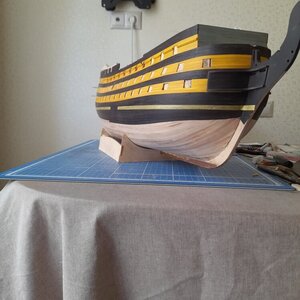
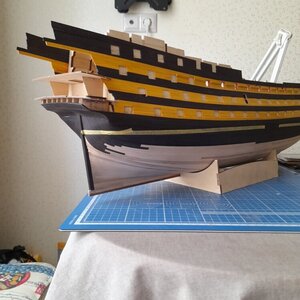
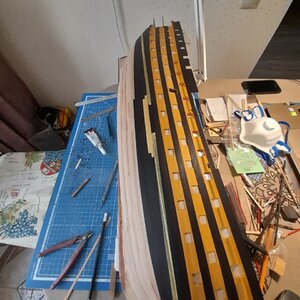
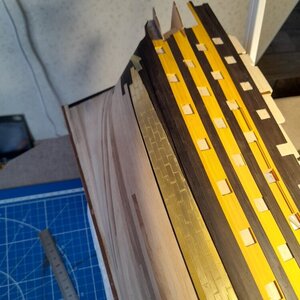

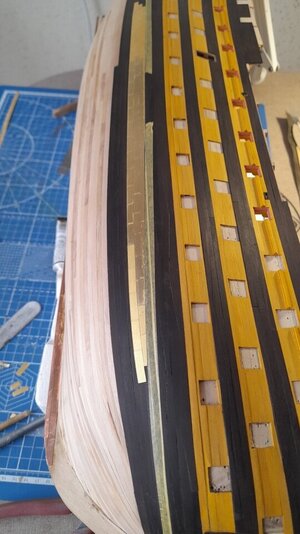
And so, from the beginning, I marked out the top line along which the skin will go. On Victory, the top 12 rows are different from the bottom. The laying scheme was a little earlier in post No. 268. So far I have laid 150 sheets. Spent about 7 hours on this. I assume that there will be approximately 2,000 sheets. Of course, I will not lay out each row, but I will show the main stages. So don't lose me






So far I have laid 150 sheets. Spent about 7 hours on this. I assume that there will be approximately 2,000 sheets.
Rather you than me Sasha, but it's looking great so far, good luck

- Mark
appr. 20 sheets per hour - not so bad speed -> you will see, that with the time it will go faster
Which type of "plates" or producer are you using? Because we can see, that the show already the nails so I guess they are prefabricated.....
How are they fixed to the hull - with CA-glue like in your post #290?
Which type of "plates" or producer are you using? Because we can see, that the show already the nails so I guess they are prefabricated.....
How are they fixed to the hull - with CA-glue like in your post #290?
Sasha I can only repeat what others have said before, your work is excellent.
I am curious, is it copper or brass sheathing that is not permitted in competition? The company I used to work for was involved in the restoration of Cutty Sark.The hull is plated with Muntz metal which to look at, looks little different from Brass.
Kind Regards
Nigel
I am curious, is it copper or brass sheathing that is not permitted in competition? The company I used to work for was involved in the restoration of Cutty Sark.The hull is plated with Muntz metal which to look at, looks little different from Brass.
Kind Regards
Nigel
Uvek, these are ready-made plates from the Russian company Microdesign. They are cut to size and have imitation rivets on them.appr. 20 sheets per hour - not so bad speed -> you will see, that with the time it will go faster
Which type of "plates" or producer are you using? Because we can see, that the show already the nails so I guess they are prefabricated.....
How are they fixed to the hull - with CA-glue like in your post #290?


